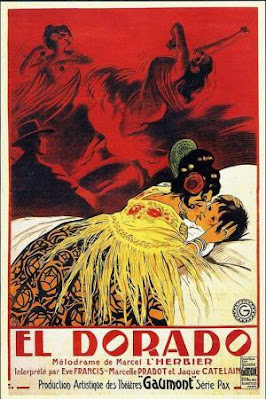 |
| Marcel L'Herbier: El Dorado (FR 1921) starring Eve Francis (Sibilla). |
Alhambran tanssijatar.
(Gaumont [Série Pax], FR 1921) D+SC: Marcel L’Herbier; DP: Georges Lucas; AD: Robert-Jules Garnier, Louis Le Bertre; ass. D: Dimitri Dragomir, Raymond Payelle [Philippe Hériat]; filmed: 10.3- 5.1921 (Granada [Alhambra], Seville, studio: Gaumont [Butte Chaumont], Paris);
cast: Eve Francis (Sibilla), Jaque Catelain (Hedwick), Marcelle Pradot (Iliana), Philippe Hériat (the jester João), Georges Paulais (Esteria), Claire Prélia (the countess), Edith Réal (Concepción);
35 mm, 2025 m, 99' (18 fps), col. (tinted); from: Archives Gaumont-Pathé, Paris.
Intertitres français.
Original score by Marius-François Gaillard performed at the piano by Touve Ratovondrahety.
Viewed at Teatro Verdi, Le Giornate del Cinema Muto, Pordenone, e-subtitles in English and Italian, 3 Oct 2011.
The GCM Catalogue: "For the third time Touve Ratovondrahety interrupts his energetic programme as composer, pianist, organist, and accompanist for the ballet of the Opéra de Paris to arrange and perform a piano transcription of an original period film music score. In 2009 he played Ernesto Halffter’s 1924 score for Feyder’s Carmen (now recorded for the first time with orchestra by Mark Fitz-Gerald), and in 2010, Noël Gallon’s transcription of Henri Rabaud’s score for Raymond Bernard’s Le Miracle des loups (1924)."
"The score for El Dorado was composed by 21-year-old Marius-François Gaillard (1900-1973), a pianist and conductor who was subsequently to collaborate with L’Herbier on his sound films, La Route impériale, Les Hommes nouveaux, Histoire de rire, and La Révoltée. In a 1968 interview with J.A. Fieschi, L’Herbier recalled: “El Dorado was, I believe, the first film to have a synchronous symphonic score, which was composed by Marius-François Gaillard (…) Gaillard’s music had the exact duration of the film, and at the Gaumont-Palace, where it was shown, the orchestra was composed of seventy musicians … It was a permanent musical counterpoint which gave the film a quite special and unprecedented dimension. Anyway, I am one of those who think that a totally silent film is difficult to bear without accompaniment. If this accompaniment does not accompany [El Dorado], it would definitely be necessary to remake the editing of the film: certain shots seem much too long without the support of the music (…)"
"“What I sought with El Dorado is for the music to be a perpetual accompaniment, not only to the image, but also to its content, the reaction of the characters, their angers, their passions. I thought that the image alone did not create the total emotion, and that the music was like a red thread stretched between the spectator and the film, to bring a whole supplement to the film, a super-film. All the more so, that silence, in the silent film, was only illusory, that there were words, and that these words, through the play of intertitles and mime, could have a quite explosive evocatory power, to which the music could only add."
"“Gaillard wrote his score after the film was finished, which allowed him to be the final intermediary between the film and the screen. And the fact of seeing the film entirely edited forced him into extremely precise timings, as well as musical enchaînements corresponding to the enchaînements of film sequences: he also comprehended the global idea of the film, so well that the music did not seem something artificial and a veneer, but appeared to rise out of the images themselves.” At this time L’Herbier believed the score was lost, but in 1983, with the help of the director’s family, it was rediscovered by Theodor van Houten, who organized a production with Het Brabant Orchestra, performed five times in Holland, Belgium, and Paris. Apart from these and a 1995 show at CinéMémoire in the Paris Cirque d’Hiver, the great size of the orchestra (the Brabant used 80 players) has inhibited any subsequent attempt." – DAVID ROBINSON
"In El Dorado and its music, despite its drama, I find a certain French “champagne” spirit: subtlety, lightness, elegance, symbolism and poetry. There is a difference between this work and that of Henri Rabaud for Le Miracle des loups. Rabaud develops his leitmotivs in the style of Wagner to characterize situations and characters. Marius-François Gaillard favours a style of orchestral effects with complex chords and often superimposes melodies with completely independent rhythms, rhythms often in 5 or 7 time. It is easily accomplished with an orchestra of 70 musicians, but I admit that it is a little more complicated with a piano." – TOUVE RATOVONDRAHETY
AA: A beautiful 1995 restoration of one of Marcel L'Herbier's best films.
Lenny Borger told me after the screening that the full orchestra score by Marius-François Gaillard is available on dvd, which I look forward to seeing and listening to. I confess that I could not make sense of the original orchestra music score from the piano interpretation. Certainly this is a musical film that could inspire a wonderful Spanish-style film event. The female protagonist is a gypsy dancer, and some passionate flamenco would fit the bill.
In its restored version El Dorado is a full artistic experience, including the design of the poetic titles and the colour world, which is impressively recreated on this print.
El Dorado is a tragedy starring Eve Francis as the dancer Sibilla who fights for the life of her son, abandoned by the father Esteria, the richest man of the district. Esteria's legitimate daughter Iliana elopes with her Swedish lover Hedwick on her betrothal night (yet another case of cinema's obsession with the cancelled wedding or the cancelled betrothal), and Sibilla finally joins forces with Iliana and Hedwick before driving the dagger into her chest.
The composition of the image and the sense of light are wonderful. L'Herbier was a master of the first French avantgarde, famous as a pioneer of "visual music". I hope to revisit this film in a film concert with a full symphony orchestra.
No comments:
Post a Comment